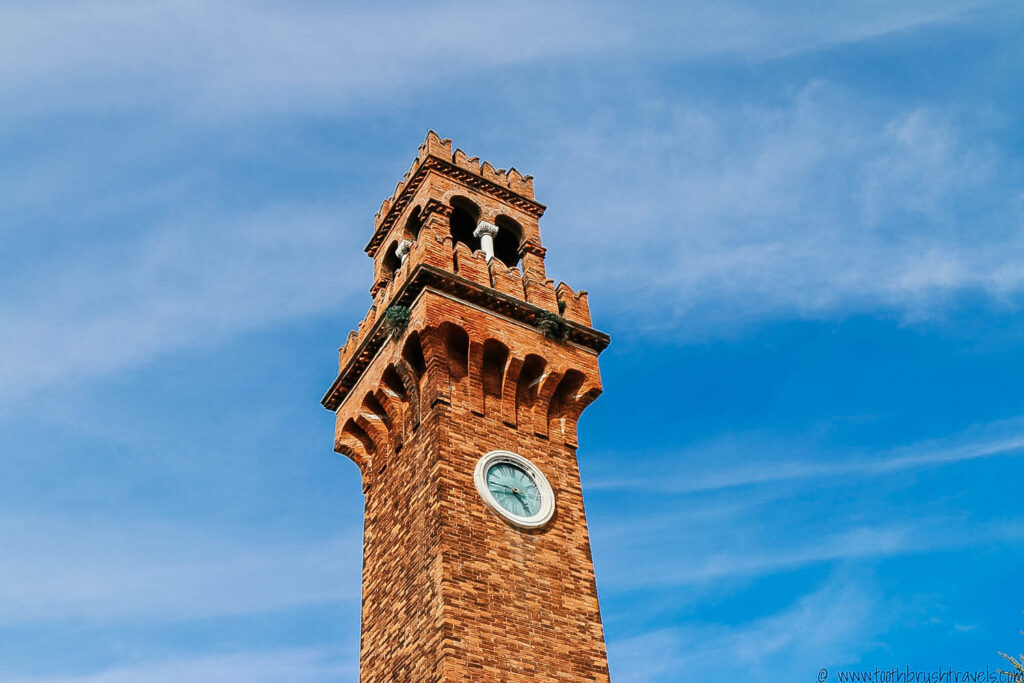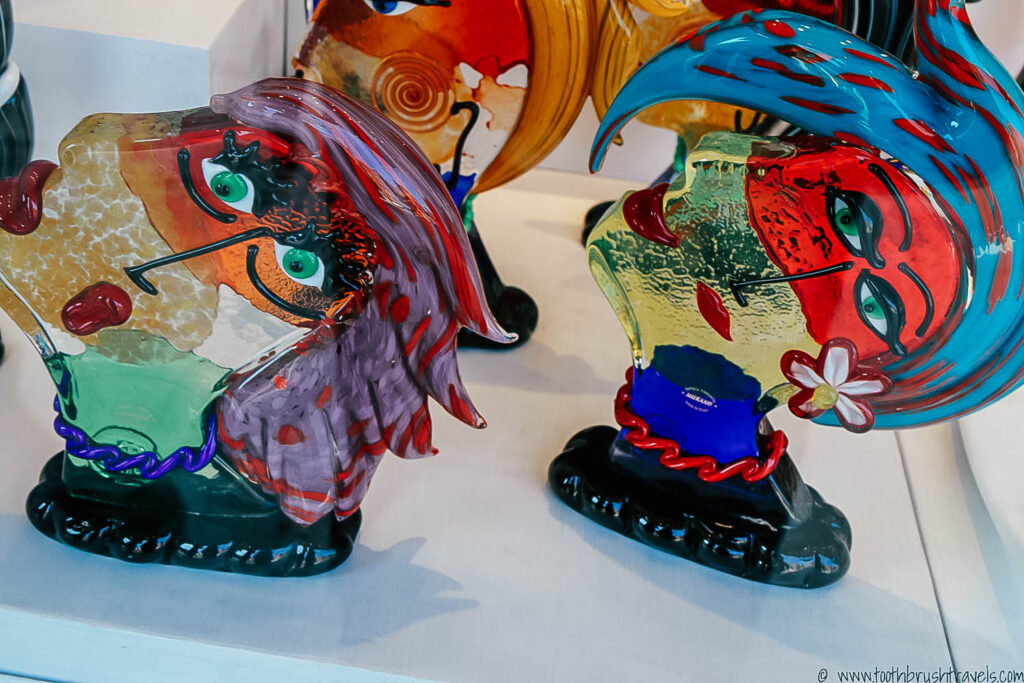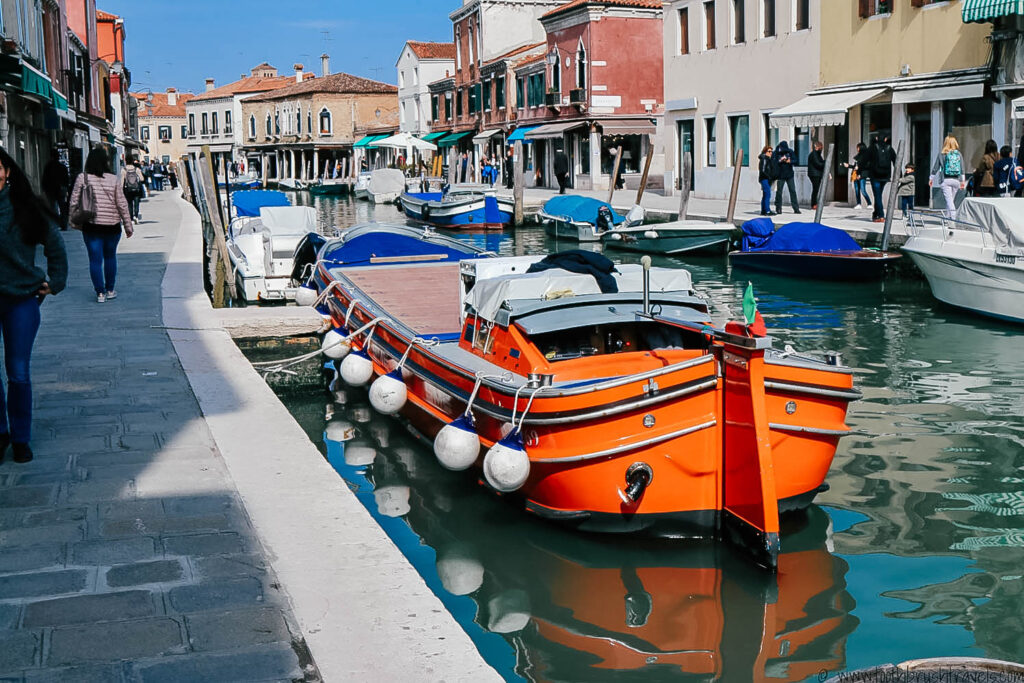When I found myself in Venice for two days I couldn’t help but look for things to do in Murano. After spending my first day roaming around the city, getting lost in the labyrinth of walkways, I wanted day two to be a little bit different. To be a day of venturing further afield. Which is how I ended up on the island of Murano.

Situated just to the North of Venice, Murano is a series of islands that have been connected by bridges—making it easy for the 5,000 or so people which populate the island, to move around freely. You can get to Murano via Waterbus—and you’ll be pleased to know that walking around those bridges isn’t the only thing to do in Murano!
The island itself has had a colourful history, with the first settlers dating back to Roman times, before people from Oderzo and Altinum (two ancient coastal towns) settled on the island in the sixth century. From here the island prospered as a fishing port. Which makes sense, ya’ know, because Venice is on water. But outside of this, it was also popular for salt. Times have changed though, because nowadays Murano’s popularity has stemmed from its reputation for glass, with the island’s glassblowing museums/shows being one of the top things to do in Murano.
You can make your own item with a glass master and take it home, you can attend glassblowing workshops and you can go to glass factories!

The popularity of glassblowing dates back to 1921 when all of the glassmakers in Venice were required to move to Murano due to fears that their furnaces would burn down all of the wooden buildings on Venice’s main island. During this time it became one of the top exports, propelling the island of Murano to fame. It was the export of glass beads and mirrors which helped obtain that fame, with chandeliers adding to this later on. The glassmakers were pretty dang good at this, and the island inhabitants went on to invent Aventurine glass and for a while became Europe’s main glass producer. This fame continued until the 18th century when the island of Murano saw a slight decline. However, it’s still the island’s main industry—something which is evident when you step onto the island.
So, how do you get to that island?

How To Get To Murano From Venice
When you find yourself in Venice looking for things to do in Murano, you’ll find that it’s pretty easy to get to each island. But the best option to cross the water will depend upon where on the island you are. If you’re heading to Murano from S.Zaccaria (near Piazza San Marco) you’ll want to take the ACTV (Venice’s transit company) waterbus along Line 4.2 or 4.1. Alternatively, if you’re heading to Murano from the railroad station you can ride Line 3 (known as Diretto Murano) which will take you to Murano Colonna in about 17 minutes.
You can get off at any stop but there are certain stops which are best to get off at if you’re looking for particular things to do in Murano. For example, if you’re heading to the Glass Museum or Basilica, get off at Museo. Or if you’re going for a glassblowing demonstration then get off at Colonna. But what other things are there for you to see on Murano?
Learn About The Island’s History Of Glassblowing
One of the best things to do in Murano is look at the traditional blown glass. One of the island’s oldest glass factories (Pauly & C. – Compagnia Venezia Murano) is still active today—a record feat considering it was founded in 1866. The island is famed for the generations of craftsmen who have been creating glass in factories and laboratories—to the point that the glassblowing helped to make Murano one of the best-known islands in the lagoon of Venice. And that wasn’t by accident.
Murano’s reputation for glass-making has developed over the years, and the skill and technique didn’t only propel them to fame but earned respect along with it. By the 14th century, Murano’s glassmakers were numbered among the most prominent citizens on the island, finding their daughters married into Venice’s most affluent families, enjoying immunity from prosecution by the Venetian State and they were even allowed to wear swords. I mean, it must have made accessorizing pretty difficult, BUT THEY COULD WEAR SWORDS. One of the conditions were that the glassmakers were not allowed to leave the Republic, but many took that risk and left to set up shop in England, The Netherlands and often even further afield.

But even today, glassblowing is still a stand out feature of the island, something which is immediately obvious when you pass each shop window. The island of Murano houses some of the most important brands of glass in the world, including Alessandro Mandruzzato, Venini, Barovier & Toso, Seguso, Simone Cenedese and Ferro Murano. But as with all popular places, you should be cautious when shopping for that renowned glass, as there are some shops which will try to pass off imported glass as authentic. Which is why it’s important to note that glass created on Murano will have a Vetro Murano Artistico trademark, so you’ll be able to identify it’s authenticity, as only the real deal will have the symbol.
If you’re not looking to buy glass, but still find the history interesting enough to include as one of your things to do in Murano, you can still enjoy it as Murano is home to the Murano Glass Museum (otherwise known as the Museo del Vetro) in the Palazzo Giustinian, the Mazzega Glass Factory and Schiavon Art Team. Each glass museum offers something different, but the Murano Glass Museum holds numerous displays on the history of glassmaking, including samples which range from as far back as Egyptian times, to samples from the current day—making it one of the top things to do in Murano if you’re looking to catch a glimpse into the island’s history.

Walk Along Murano’s Canal Grande
With those meandering waterways and unique buildings, it’s undeniable that each part of Venice is beautiful. But unlike some of the neighbouring islands such as Burano, Murano is a little bit quieter—making it the perfect place to make the most of the thinner crowds by snapping photos of the waterways and Ponte Vivarini without worrying about other people being in the background! Much like Venice proper, the island of Murano is split into two, only Murano is split by its very own Canal Grande. A canal which is much smaller than that seen on Venice, but due to the aforementioned lack of crowds makes it a fine spot to explore!
Check Out Chiesa di San Pietro Martire
It’s not often you go on holiday and find yourself wanting to wander around a Roman Catholic parish church, but Chiesa di San Pietro Martire is a cultural site visited by international tourists and a weekly destination for religious local Christians. The Chiesa di San Pietro Martire was originally built in 1348 but was completely destroyed in 1474 and so the church that stands today dates back to 1511 and features some peculiar aspects of Renaissance art—including some beautiful paintings created by 16th-century artists.

Look At The Cometa di Vetro
Following along the above theme of glassblowing brings us to the Cometa Di Vetro, or if you want to put it simply—the big blue glass thing in the above photo. Simone Cennedesse, one of Venice’s most important glass brands/makers, designed the glass sculpture in 2008 for the Natale di Vetro celebration—an annual celebration in Murano which lasts for a month, starting on St. Nicholas Day. The official title is “Natale di luce in una Cometa di Vetro” meaning “Christmas of light in a glass comet” and the beautiful blue sculpture has become a symbol of Christmas on Murano—taking a permanent display at Campo Santo Stefano.

Stop And Eat!
If you’re anything like me, walking so many steps tends to work up an appetite. Luckily, there are plenty of restaurants and bars available on Murano. Situated in a multi-functional restaurant that offers carbs and coffee for those who need a break, B Restaurant Alla Vecchia Pescheria is a local favourite, but be warned—it gets busy so plan ahead! Or if you want something a little lighter, there are plenty of osteria and gelaterias available.
Visit The Basilica di Santa Maria e San Donato
If you’re looking to see exquisite, Ravenna-quality Byzantine mosaics which cover the floor and dome of Basilica of Saint Mary and Saint Donatus, then the Basilica di Santa Maria e San Donato is for you. Dating back to the 7th century, it’s quite the throwback and the outside bell tower contains more than just the bones of saints. Instead, you’ll find relics of St. Donatus, and four rib bones which measure more than 1 meter in length and supposedly comes from a dragon that St. Donatus slew…
